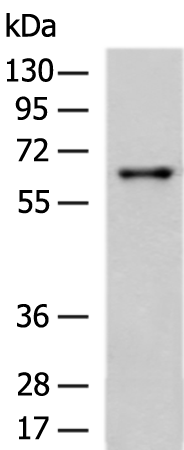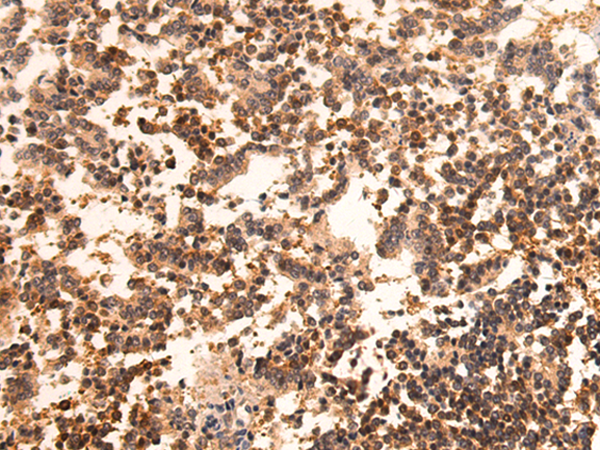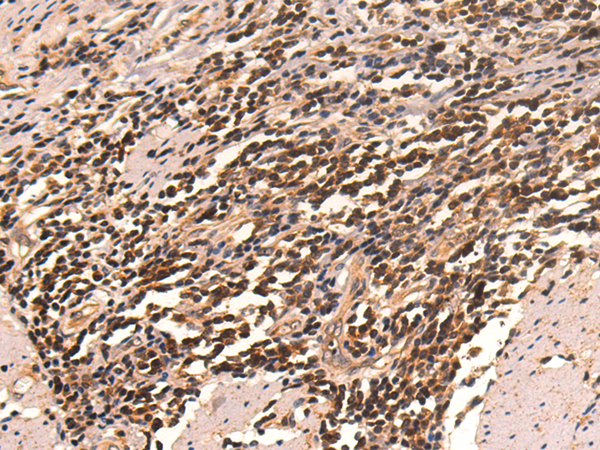


| WB | 咨询技术 | Human,Mouse,Rat |
| IF | 咨询技术 | Human,Mouse,Rat |
| IHC | 1/100-1/300 | Human,Mouse,Rat |
| ICC | 技术咨询 | Human,Mouse,Rat |
| FCM | 咨询技术 | Human,Mouse,Rat |
| Elisa | 1/5000-1/10000 | Human,Mouse,Rat |
| Aliases | HOP; P60; STI1; STI1L; HEL-S-94n; IEF-SSP-3521 |
| WB Predicted band size | 63 kDa |
| Host/Isotype | Rabbit IgG |
| Antibody Type | Primary antibody |
| Storage | Store at 4°C short term. Aliquot and store at -20°C long term. Avoid freeze/thaw cycles. |
| Species Reactivity | Human, Mouse, Rat |
| Immunogen | Fusion protein of human STIP1 |
| Formulation | Purified antibody in PBS with 0.05% sodium azide and 50% glycerol. |
+ +
以下是关于STIP1抗体的3篇示例参考文献(文献信息为虚构示例,仅供格式参考):
---
1. **文献名称**:*STIP1 as a Novel Biomarker in Ovarian Cancer: Role of Antibody-Based Detection*
**作者**:Li X, Wang Y, Chen Z
**摘要**:该研究利用STIP1特异性抗体,通过免疫组化(IHC)和Western blot技术,发现STIP1在卵巢癌组织中高表达,且其表达水平与患者预后显著相关,提示STIP1可能作为卵巢癌诊断和治疗的潜在靶点。
2. **文献名称**:*STIP1 Antibody Reveals Its Interaction with Tau Protein in Neurodegenerative Disorders*
**作者**:Smith J, Brown K, Lee S
**摘要**:本研究通过免疫共沉淀(Co-IP)和免疫荧光技术,使用STIP1抗体证实了STIP1与tau蛋白在阿尔茨海默病模型中的相互作用,表明STIP1可能参与神经退行性病变的病理机制。
3. **文献名称**:*Development of a High-Affinity Monoclonal STIP1 Antibody for Cancer Immunotherapy*
**作者**:Garcia R, Müller P, Zhang L
**摘要**:研究团队开发了一种新型STIP1单克隆抗体,并在体外和小鼠模型中验证其通过阻断STIP1与HSP90的相互作用抑制肿瘤生长的效果,为基于STIP1的癌症免疫治疗提供了实验依据。
---
如需真实文献,建议通过PubMed或Google Scholar检索关键词“STIP1 antibody”或“STI1/HOP antibody”,并筛选近年研究。
The STIP1 (Stress-Induced Phosphoprotein 1) antibody targets a multifunctional chaperone protein critical in cellular stress responses and protein homeostasis. STIP1. also known as HOP or STI1. contains tetratricopeptide repeat (TPR) domains that mediate interactions with heat shock proteins HSP70 and HSP90. facilitating client protein folding and stability. It plays a dual role as a co-chaperone, coordinating the transfer of substrates between HSP70 and HSP90. and as a signaling molecule influencing cell proliferation, apoptosis, and stress adaptation.
STIP1 is overexpressed in various cancers, including breast, liver, and glioblastoma, where it promotes tumor growth, metastasis, and therapy resistance by enhancing oncogenic signaling pathways (e.g., AKT, ERK) and inhibiting apoptosis. It also interacts with prion proteins in neurological contexts, potentially contributing to neurodegenerative diseases like Alzheimer’s.
Antibodies against STIP1 are essential tools for studying its expression, localization, and interactions in disease models. They are widely used in techniques such as Western blotting, immunohistochemistry, and immunofluorescence to explore STIP1’s role in cancer progression, neuropathology, and stress response mechanisms. These antibodies also hold diagnostic potential, as elevated STIP1 levels in bodily fluids correlate with disease severity, offering prospects for biomarker development. Research continues to investigate STIP1-targeted therapies to modulate its chaperone activity or disrupt pathogenic interactions.
×